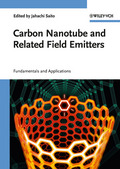Carbon Nanotube and Related Field Emitters
Fundamentals and Applications

1. Edition July 2010
XXIV, 480 Pages, Hardcover
358 Pictures
Monograph
Wiley Online LibraryContentSample ChapterPDF Chapters 8 – 10
Buy now
Price: 179,00 €
Price incl. VAT, excl. Shipping
Euro prices for Wiley-VCH and Ernst & Sohn titles are only valid for Germany. In EU countries, local VAT applies. Postage will be charged.
- Out of print -
Carbon nanotubes (CNTs) have novel properties that make them potentially useful in many applications in nanotechnology, electronics, optics and other fields of materials science. These characteristics include extraordinary strength, unique electrical properties, and the fact that they are efficient heat conductors. Field emission is the emission of electrons from the surface of a condensed phase into another phase due to the presence of high electric fields. CNT field emitters are expected to make a breakthrough in the development of field emission display technology and enable miniature X-ray sources that will find a wide variety of applications in electronic devices, industry, and medical and security examinations.
This first monograph on the topic covers all aspects in a concise yet comprehensive manner - from the fundamentals to applications. Divided into four sections, the first part discusses the preparation and characterization of carbon nanotubes, while part two is devoted to the field emission properties of carbon nanotubes, including the electron emission mechanism, characteristics of CNT electron sources, and dynamic behavior of CNTs during operation. Part three highlights field emission from other nanomaterials, such as carbon nanowalls, diamond, and silicon and zinc oxide nanowires, before concluding with frontier R&D applications of CNT emitters, from vacuum electronic devices such as field emission displays, to electron sources in electron microscopes, X-ray sources, and microwave amplifiers. Edited by a pioneer in the field, each chapter is written by recognized experts in the respective fields.
Structures and Synthesis of Carbon Nanotubes
Preparation of Carbon Nanotube (CNT) Emitters
FIELD EMISSION FROM CNTS
Field Emission Theory
Field Emission Properties of CNTs
Field Emission Microscopy (FEM) of Multiwall Carbon Nanotubes
In-situ TEM (Transmission Electron Microscopy) of CNT Emitters
Field Emission from Single-Wall Carbon Nanotubes
Field Emission from Patterned Arrays
Surface Treatments of CNT Emitters
FIELD EMISSION FROM OTHER NANOMATERIALS
Graphite Nanoflakes and Diamond
Carbon Nanowalls
Si Nanowire and ZnO Nanowire
APPLICATIONS OF CNT EMITTERS
Field Emission Display
Electron Sources in Electron Microscopes
Field Emission X-Ray Sources
Microwave Amplifier
Parallel Electron-Beam Lithography
Saito?s area of expertise encompasses the synthesis, characterization and application of nanometer scale materials, especially inorganic atomic clusters and fine particles, fullerenes, and carbon nanotubes (CNTs). He has studied CNT field emitters since 1996, collaborating with Noritake Itron Corp since 1997 for the development of display devices using CNTs as a cold cathode. They demonstrated the world?s first CNT-based display device at the SID International Conference in 1998. Saito is the recipient of numerous awards, including the Yazaki Arts and Science Award (2004), the Prize for Science and Technology of the Ministry of Education, Culture, Sports Science and Technology (2006), and the 2007 SID Int. Symp. Distinguished Paper Award.


